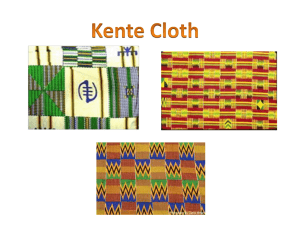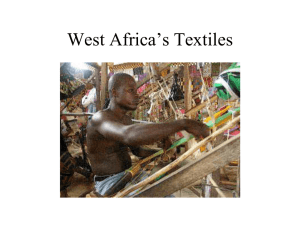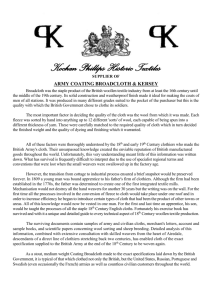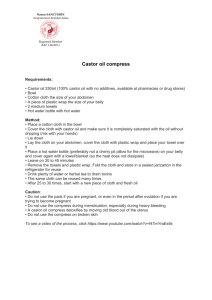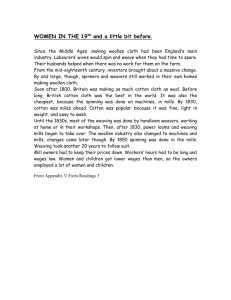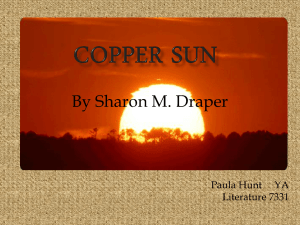KENTE - Milton Keynes Council
advertisement
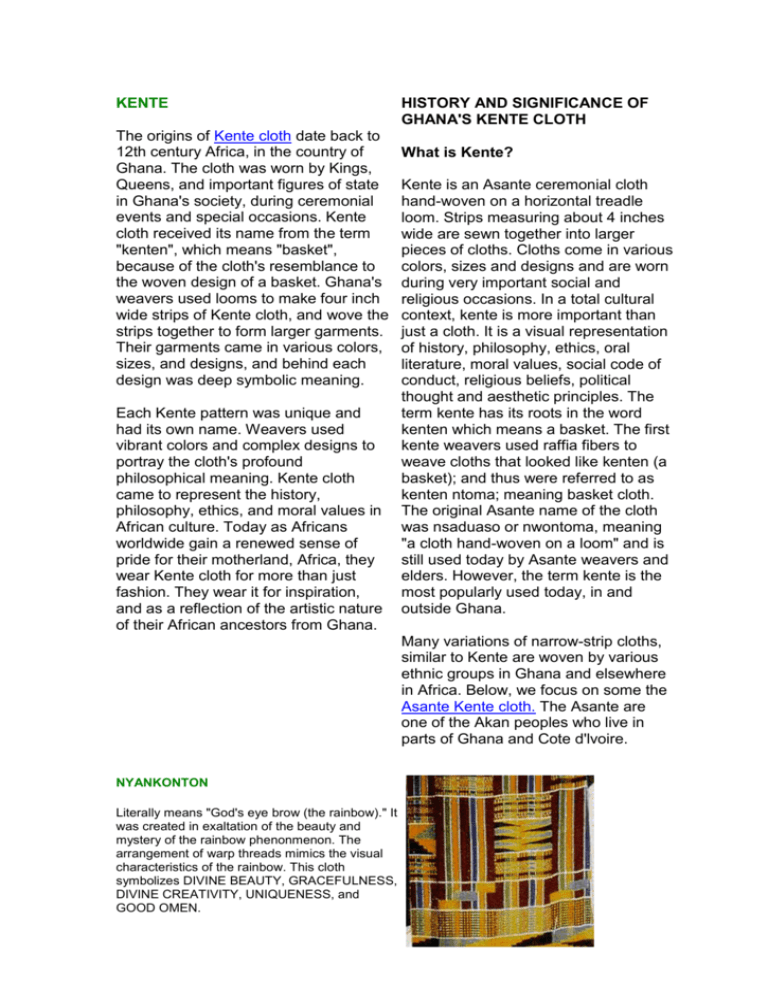
KENTE The origins of Kente cloth date back to 12th century Africa, in the country of Ghana. The cloth was worn by Kings, Queens, and important figures of state in Ghana's society, during ceremonial events and special occasions. Kente cloth received its name from the term "kenten", which means "basket", because of the cloth's resemblance to the woven design of a basket. Ghana's weavers used looms to make four inch wide strips of Kente cloth, and wove the strips together to form larger garments. Their garments came in various colors, sizes, and designs, and behind each design was deep symbolic meaning. Each Kente pattern was unique and had its own name. Weavers used vibrant colors and complex designs to portray the cloth's profound philosophical meaning. Kente cloth came to represent the history, philosophy, ethics, and moral values in African culture. Today as Africans worldwide gain a renewed sense of pride for their motherland, Africa, they wear Kente cloth for more than just fashion. They wear it for inspiration, and as a reflection of the artistic nature of their African ancestors from Ghana. HISTORY AND SIGNIFICANCE OF GHANA'S KENTE CLOTH What is Kente? Kente is an Asante ceremonial cloth hand-woven on a horizontal treadle loom. Strips measuring about 4 inches wide are sewn together into larger pieces of cloths. Cloths come in various colors, sizes and designs and are worn during very important social and religious occasions. In a total cultural context, kente is more important than just a cloth. It is a visual representation of history, philosophy, ethics, oral literature, moral values, social code of conduct, religious beliefs, political thought and aesthetic principles. The term kente has its roots in the word kenten which means a basket. The first kente weavers used raffia fibers to weave cloths that looked like kenten (a basket); and thus were referred to as kenten ntoma; meaning basket cloth. The original Asante name of the cloth was nsaduaso or nwontoma, meaning "a cloth hand-woven on a loom" and is still used today by Asante weavers and elders. However, the term kente is the most popularly used today, in and outside Ghana. Many variations of narrow-strip cloths, similar to Kente are woven by various ethnic groups in Ghana and elsewhere in Africa. Below, we focus on some the Asante Kente cloth. The Asante are one of the Akan peoples who live in parts of Ghana and Cote d'lvoire. NYANKONTON Literally means "God's eye brow (the rainbow)." It was created in exaltation of the beauty and mystery of the rainbow phenonmenon. The arrangement of warp threads mimics the visual characteristics of the rainbow. This cloth symbolizes DIVINE BEAUTY, GRACEFULNESS, DIVINE CREATIVITY, UNIQUENESS, and GOOD OMEN. AKYEMPEM Literally means "thousands shields." This is a reference to shields used by highly well organized militia consisting of thousands of men and women who defended the Asante Kingdom against external aggression. According to the military strategy of the Asante Kingdom, the chief of the shield bearers, the Akyempemhene, and the rear guards of the King are his own sons. Shields once used as military weapons are now used in royal ceremonies to symbolize and commemorate the military prowess of the Asante Kingdom. The cloth symbolizes MILITARY PROWESS, UNITY THROUGH MILITARY STRENGTH, BRAVERY, POLITICAL VIGILANCE & SPIRITUAL DEFENSIVENESS. KYERETWIE Literally means "the lion catcher." The cloth was designed to commemorate an incident during the reign of King Kwaku Dua (1838 -1867) who tested the courage of his warriors by ordering them to catch a leopard alive. The appellation, "Kyerekwie" was since appended to the names of some of the Asante Kings whose bravery and leadership qualities were comparable to the courage needed to catch a leopard alive. The black vertical warp stripes represent the black sports in a leopard's fur. In the past, the cloth was worn only by the Asantehene or by other chiefs with his permission. The cloth symbolizes COURAGE, VALOR, EXCEPTIONAL ACHIEVEMENT and INSPIRING LEADERSHIP. WOFRO DUA PA A NA YEPIA WO Literally means "one who climbs a tree worth climbing gets the help deserved." The cloth was designed to express the Akan social thought which maintains that any good individual effort deserves to be supported by the community. When one climbs a good tree that has fruits on it, people around will give him a push, since they know they will enjoy the fruits of his labor. It is a notion that reinforces the importance of aspiring towards a worthy course. Symbolizes ASPIRATION, HOPE, MUTUAL BENEFITS, SHARING and NOBLE DEEDS. TOKU KRA TOMA Literally means Toku's soul cloth. The cloth is designed and named to commemorate the soul of a warrior Queenmother of that name, who, though was defeated and executed in a battle with Nana Opoku Ware I, the King of the Asante kingdom (1731-1742), was viewed as a courageous woman. It commemorates that historic event and honors the soul of that Queenmother for her bravery. In the past, such a cloth would only be worn by the royalty and people of high rank during very sacred ceremonies in which the spirits of the ancestors are venerated. The cloth symbolizes COURAGEOUS LEADERSHIP, HEROIC DEEDS, SELF-SACRIFICE, and SPIRITUAL VITALITY and REBIRTH. EMAA DA Literally means "it has not happened before" or "it has no precedence." According to Nana Kwasi Afranie of Bonwire, the Asantehene's chief weaver, the cloth was designed and so named by one of the Asante Kings who was so awed by the uniqueness of the pattern that he remarked "Eyi de emmaa da" meaning, "this one has no precedence." The cloth was therefore reserved for the exclusive use of the King, but its use was later extended to people of high ranks. It is a symbol of CREATIVE INGENUITY, INNOVATION, UNIQUENESS, PERFECTION and EXCEPTIONAL ACHIEVEMENT. ABUSUA YE DOM Literally means "the extended family is a force." Among the Akan peoples, the extended family is the foundation of society. Like a military force, members of the family are collectively responsible for the material and spiritual well-being, the physical protection and the social security of all its members. The cloth was designed to celebrate and reinforce such positive attributes of the extended family system. In its many variations and background colors the cloth symbolizes STRONG FAMILY BOND, THE VALUE OF FAMILYUNITY, COLLECTIVE WORK and RESPONSIBILITY and COOPERATION. SIKA FUTORO Literally means "gold dust." Before the use of coins and paper as money, gold dust, was used as a medium of exchange among the Akan peoples and was therefore considered as a symbol of wealth and prosperity. The predominant use of intricately textured patterns in yellows, orange and reds replicate the visual characteristics of gold dust. The cloth symbolizes WEALTH, ROYALTY, ELEGANCE, SPIRITUAL PURITY and HONORABLE ACHIEVEMENT. OBAAKOFO MMU MAN Literally means "one person does not rule a nation." It expresses the Akan system of governance based on participatory democracy. The nine squares represent MPUANKRON (nine tufts of hair) a ceremonial hair cut of some royal functionaries who help rulers make decisions. Originally the cloth was named FATHIA FATA NKRUMA. "Fathia is a suitable wife for Nkrumah." After the military overthrow of Nkrumah, the original significance of MPUANKRON (participatory democracy) was applied to reflect the prevailing politicalatmosphere. The cloth symbolizes PARTICIPATORY DEMOCRACY and WARNING AGAINST AUTOCRATIC RULE ADWINASA Literally means "all motifs are used up." According to the elders, the designer of this cloth, attempted to weave a unique cloth to please the Asantehene. In his effort he used all the motifs then known to weavers in weaving one cloth. In the end he remarked that he had exhausted all the repertoire of motifs known to Asante weavers. The cloth was, therefore viewed as one of the top quality, and the most prestigious of kente cloths, besides those woven exclusively for Asante Kings. It was in the past, worn by kings and people of high status and wealth. It symbolizes ROYALTY, ELEGANCE, CREATIVE INGENUITY, EXCELLENCE, WEALTH, PERFECTION and SUPERIOR CRAFTSMANSHIP

